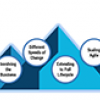Business Transformation Requires Transformational Leaders
Leadership and teaming skills are front and center in times of rapid change. Meet today’s constant disruption head on with expert guidance in leadership, business strategy, transformation, and innovation. Whether the disruption du jour is a digitally-driven upending of traditional business models, the pandemic-driven end to business as usual, or the change-driven challenge of staffing that meets your transformation plans — you’ll be prepared with cutting edge techniques and expert knowledge that enable strategic leadership.
Subscribe to Arthur D. Little's Culture & Leadership Newsletter
Insight
Business Architecture: Lessons from the Trenches
In this Executive Update, Cutter Senior Consultant Whynde Kuehn highlights some of her responses to a recent Q&A session from a webinar and expands on some key aspects of successful business architecture practices.
Effective digital IT strategies and successful execution of long- and short-term plans enable organizations to realize the goals of digital business strategies and provide guidance to enterprise architecture.
Discover how pilot projects for digital innovations can benefit from adopting an Agile development approach.
Advice on technology strategy, the skill gaps, and the new roles and responsibilities you need to ensure you have the expertise and the streamlined, agile organizational structure that digital demands.
Strategic Cloud Procurement Assessment
Cutter Senior Consultant James Mitchell has developed a revolutionary way to determine how you can optimize your cloud use. Whether you’re moving to the cloud or looking to save on your cloud investment, Dr. James Mitchell provides the tools and insight to help you understand cloud procurement and optimize your cloud computing spend.
Investing in the Crowd
Peer-to-peer financing in the form of crowdfunding is increasingly filling a funding gap for companies that are unable to obtain traditional financing or are too early in their lifecycle to attract angel investors and venture capitalists.
Jan-Paul Fillié and Hans Boer talk about the “hills” an organization must surmount to implement Agile at scale. Based on their experience with numerous transformations, Fillié and Boer offer helpful advice on resolving such challenges as changing the organizational culture, coping with teams that deliver at different speeds, coordinating dependencies, and distributing Agile practices.
One of the hallmarks of a mature Agile team is continuous learning. “But,” asks author Jeff Dalton, “do Agile leaders know how and what to teach?” Dalton argues that after decades of “vo-tech” style learning, it’s time for a return to “the collaborative, interpersonal, and analytical skills that ... are so important for successful Agile adoption.” He introduces the Agile Performance Holarchy.













